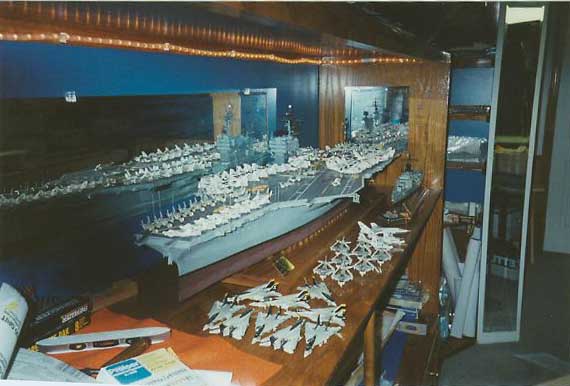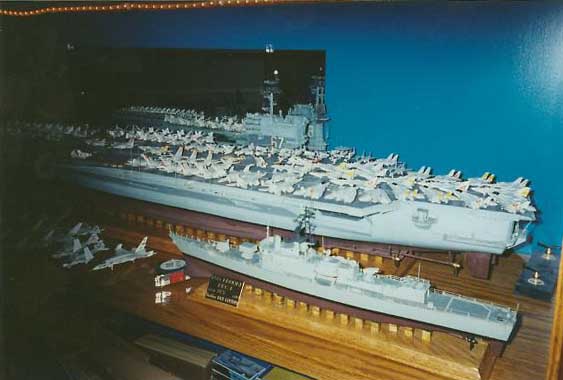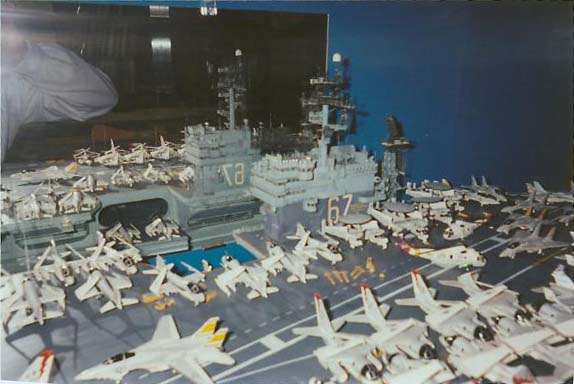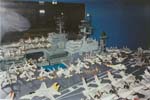Building a 1:144 Scale Radio-Controlled USS Nimitz:
by Dan Linton

I have always been interested in things military and would
likely have joinedthe navy had I not been a Canadian and spent my entire adult life
watching cutbacks. Canada's only carrier (HMCS Bonaventure) was scrapped the year I
had to make a career decision and the prime minister of the day, speaking to sailors on a then-modern
destroyer, actually suggested that fishery patrols would be an important part of their
future! And I remembered "Black Friday" in February 1959 when the
CF-105 Avro Arrow was cancelled. My father, who served in the RCAF in WWII,
was one of the
14,000 made instantly unemployed that day. So it was that I became a teacher andnot a
serviceman. More years ago than I am willing to admit here, I fulfilled a teenage ambition and
completed a large, radio-controlled aircraft carrier.
The
pictures that accompany this section show a 1:192 scale USS John F. Kennedy. It is because of
the experience in building this ship that I went 'upscale' to 1:144 on my next
carrier.
The main radar,
AN/SPS-48, which was on the island on the Kennedy and not on the large tower
behind the superstructure, was designed to rotate (a small motor is inside the island).
Truth to tell, it never worked well. The ship itself sailed adequately, but leaked up
through the shafts somewhat and the rudders were only mildly effective -- the turning
radius was very wide. And then, there was the problem of access to the interior.

The flight deck on the Kennedy is thin sheet plastic
(0.020') over balsa, held together with two-part expoxy resin (5 minute setting). There are
two panels, about 6' (15cm) x 9'or 10' (22-25cm) which are lifted up off the flight
deck to allow access -- but only to the hangar deck. The floor of the hangar deck is
0.040 styrene and in three pieces which are removeable. In other words, five pieces
have to be removed for access to the motors. Further, because of delicate antennae,
it made sense to remove the superstructure and radar tower: otherwise, one is
asking for sorrow and repair work. I resolved to create a better system on my next model.
At the time there were no PE sets in 1:192 nor any other
fittings in this scale for modern vessels. As well, there were no aircraft in 1:192 nor any
decals. And this is what determined the change to 1:144. When you look at the pictures
of the Kennedy, keep in mind that every marking had to be cut from sheets of solid
colour decal paper or, and I spend dozens of hours in search of these, appropriate sheets
of 'Letraset'. Every number and every 'NAVY' on each of those planes came from a
'Letraset' rub-on sheet. And the planes themselves were each carved from balsa. The E-2's
actually have part of a nail in the front fuselage to prevent them from being
tail-sitters. It is this massive amount of work involved in creating the airwing that determined a
change in scale, and
when LS came out with a 1:144 F-14, and Arii and Otaki produced 1:144 F-4B's
and F-8C's, I knew where I was headed. The Kennedy pictures look good, but in large part that
is because I cleaned and dusted it, and repainted the flight deck and other parts of the ship
last year. It had suffered through four changes of household in ten years and was looking
terrible. Its escort, USS
Brooke, was also cleaned up and both were given new display stands. And while I would
really like to produce an escort or two for the 1:144 Nimitz (preferably DLGN-25 Bainbridge
and CGN-36 California) I suspect I will move on to another carrier. I once built a 1:384 USS Enterprise, CVN-65 (it did not
survive the years) and am amazed by the explosion today of injection-molded and resin 1:350
scale models and the incredible detail they possess! One can build an entire fleet in
reasonable time-frames.

Oh
well, I'm committed to finishing the Nimitz that I have. The rest of the article will be as follows:
-
Section II: The Air Wing: Part 1: Fighters and Attack Aircraft
-
Section III: The Air Wing: Part 2: The Rest of CVW-8
-
Section IV: The Hangar Deck
-
Section V: Hull: Interior and Exterior
-
Section VI: Flight Deck
-
Section VII: Superstructure
-
Section VIII: Launch and Lessons learned.
Why the Air Wing first? Simply because it is essentially
finished, as is the hangar deck. I'am presently working on the sponsons that underhang the flight
deck. My goal is to have everything completed by November -- then again, where does the road
paved with good intentions lead to?
And I will be thanking several people in the course of writing this article, but let me begin
with Zoltan Pocza, known to us as 'neu', for taking the time and trouble to create this website
for us.
END OF SECTION I
